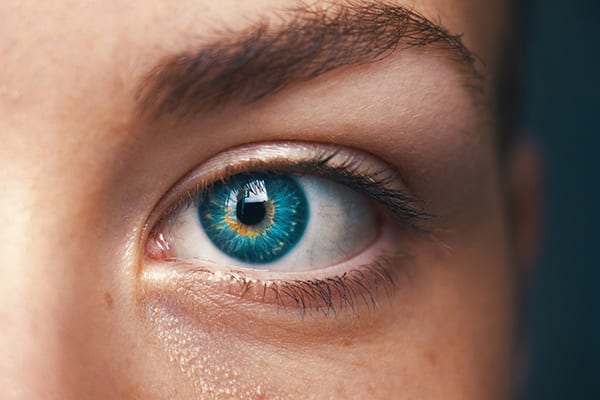Here’s some fitting guidelines and steps for your patient if you advise him monovision with contact lenses as an option for presbyopia
Step 1. Assessing the Ocular dominance and identifying the dominant eye:
Generally, the visual system is able to suppress an image in the non-dominant better than the dominant eye, and it is for this reason that ocular dominance should be assessed. The preferred means of assessing ocular dominance include ‘pointing’ and ‘sighting’. In the former, patient is asked to clasp their hands together with forefingers pointing out like a child pretending to fire a gun. They are then asked to keep their eyes open and to point the fingers at one of the practitioner’s eyes, with the practitioner sitting at the opposite end of the room. The practitioner then looks to see which of the patient’s eyes the fingers are lined up with — this is the dominant eye. In sighting, the patient holds a card with a hole at arm’s length, with the practitioner asking him or her to view a distant object. Once the object is sighted, the practitioner again looks to see which of the patient’s eyes is lined up with the object. This is the dominant eye.
identifying the dominant eye test.
Step 2: Do a good refraction and fit the Dominant eye with distance power and non-dominant eye with near power
For the majority of patients, a good starting point in selecting appropriate lens power is to use trail lenses (preferably one-day disposable) and fit the dominant eye with the maximum distance correction (as per the spectacle to contact lens calculation) and then the non-dominant eye with the least plus providing clear near vision.
Step 3.: Assess visual acuity binocularly for distance and near with the trials lenses
The first task for the practitioner is to encourage the patient to appreciate subjective near and distance visual acuity on the chart and situations in the clinic. The ability to do this occurs at a subconscious level, so the practitioner should not immediately explain how the vision has been corrected. Under binocular viewing, looking at a high contrast, well-illuminated distance chart, the patient should be asked to read as far down the chart as possible without comment on visual quality. The patient should then be directed towards a high-contrast near type, with illumination again being high to maximise the chances of seeing the image. Once again, the patient should be asked to read as far as possible. If they are unable to read the distance or the near type, the practitioner should not, at this stage, occlude either eye. Instead, the ‘non-viewing eye’ (the one that has the out-of-focus image) should be progressively blurred with spherical lenses until the image comes into view. When the distance or near type is seen clearly, the amount of blur should be progressively reduced while asking the patient to continue to read. Once the full extent of the blur has been removed, the patient should be asked to view a distant object and then return to reading. This technique will demonstrate the ability of the patient to suppress the ‘non-viewing’ eye.
Achieving a satisfactory distance and near vision matching his life style is what is targeted.
Let us take an example: A 43-year-old presbyope with spectacle prescription
RE -3.50 DS ( 6/6 )and Left eye – 2.75 Dsph ( 6/6 ) near add +1.00 D sph both eyes N/ 6 needs contact lens . Step one identify need and motivation to wear lenses. . Identify the dominant eye – let’s say its left eye in this case. Calculate empirically and order a one-day disposable contact lens Right eye -2.50 for near (as it is non dominant eye) and -2.75 for left eye. Insert the lens on the eye and check vision binocularly. If 6/6, N/ 6 done order the same. You may have to fine tune to make distance sharper or near sharper based on the response. Do only in 0.25 steps and that too binocular.
In some patients we may have to cross over to prescribe the non-dominant eye for distance .It depends on the adaptation
Step 4 : Dispense lenses and advise adaptation .
There may be intial adapdation of some depth perception loss for finer works .Like thereading a needle . More the near add more is the steropsis loss .This works best in adds belwo +1.50 .Higher adds are difficult to adapt in finer work .
Careful advice needs to be given to patients about driving and other vocational tasks that might be affected by monocular blur and impaired stereopsis. Patients should not carry out these potentially dangerous tasks until they have adapted to monovision and feel that their visual function is not impaired.
Careful advice needs to be given to patients about driving and other vocational tasks that might be affected by monocular blur and impaired stereopsis. Patients should not carry out these potentially dangerous tasks until they have adapted to monovision and feel that their visual function is not impaired.
Credits
Prof Monica Chaudhry, Sushant Shah, Roshni Sengupta, Kamal Thakur
Reference
1. Beers AP, van der Hyde GL. Age-related changes in the accommodation mechanism. Optom Vis Sci 1996; 73:235-42.
2. Maisel H, Ellis M. Cytoskeletal proteins of the aging human lens. Curr Eye Res 1984; 3:369-81.
3. Kleinstein RN. Epidemiology of presbyopia. In: Stark L, Obrecht G, eds. Presbyopia: recent research and reviews from the third international symposium. New York: Professional Press Books, 1987:12-8.
4. Michaels DD. Visual optics and refraction: a clinical approach, 3rd ed. St. Louis: CV Mosby, 1985:419-22.
5. Bennett ES. Remba MJ, Weissman BA. Contact lenses and the elderly patient. In: Rosenbloom AA, Morgan MW, eds. Vision and aging, 2nd ed. Boston: Butterworth-Heinemann, 1993:251- 89.
6. Bruce J. W. Evans. Monovision: a review. Ophthal. Physiol. Opt. 2007 27: No. 5
7. The IACLE Contact Lens Course. Module 8- Special Contact Lens Fitting
8. Gary L. Mancil, Ian L. Bailey, Kenneth E. Brookman, J. Bart Campbell, Michael H. Cho, Alfred A. Rosenbloom, James E. Sheedy. Care of the Patient with Presbyopia. American Optometric Association, 2011
9. Managing the Presbyope, Essential Contact Lens Practice
10. Gary Heiting. Monovision with contact lenses. All About Vision









